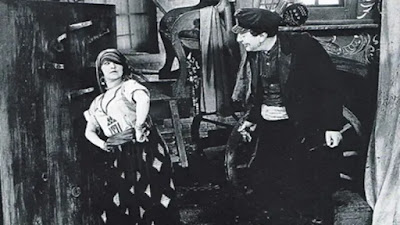I can't help but get some Tod Browning entries here early in Spooktober. Browning arguably became one of the earliest (at least in America) directors associated with the horror genre. Today we have everyone from John Carpenter to Ari Aster, David Cronenberg to James Wan, Tobi Hooper to Robert Eggers, and the list goes on. And while the world of cinema had Méliès from France, Murnau from Germany, George Albert Smith and even the up and coming Alfred Hitchcock (not known for his dark side until the 1930's) from Britain; the U.S. had no directors that were closely associated with the genre. Sure, there are American horror films from the 1910's and very early 1920's, but Brownings turn toward the dark side in the 1920's cemented in his own mind a desire to present truly gothic cinema and films with darker elements. This may have been in no small way to do with his close association with Lon Chaney. Known for good reason as "the man of a thousand faces," due to his talented proficiency in self applying the heavy make-up for roles that called for complete physical transformation. But, it should also be pointed out that Browning often let Chaney inhabit roles that did not require heavy make-up at all, thus both allowing him to bring more psychological sophistication to sinister parts and prove that he was an absolute acting talent, with our without the make-up bag. By the time The Mystic was made however, Browning was just beginning to make this turn and had only The Unholy Three as his only well known Chaney film under his belt to date. He did not work with Chaney here, presumably because Chaney, was off making The Monster with Roland West. Instead we have Conway Tearle (as Michael Nash aka "the bad guy") in a supporting male role behind star Aileen Pringle as Zara (the mystic). She shines in the role and completely elevates the entire film from crime concept and conceit, to a real believable drama with real humanity and pathos. This is good, because without some added sophistication, the plot is overly simple and was nothing new. It's the old "Gypsy medium" vehicle, with a the slight plot twist of having a group of Hungarian "gypsies" imported by an American criminal "mastermind" (Tearle) to swindle an heiress out of her valuable jewels to (for Zara, of course), and sign over her other holdings him.
The plot is certainly racist by today's standards (and it was back then too, that was part of the point; adding the supposed element of criminality, that the Roma (e.g. "gypsies") were equated with criminal behavior far and wide--it was just considered acceptable racism). It was a plot that hung on longer than it should have, having even shown up in my lifetime in a Scooby-Doo episode "A Gaggle of Galloping Ghosts" (to be sure, by this time the racism is put off onto the character who is using the Gypsy disguise to ward off the Scooby Gang). But....,yes, BUT, this is a Tod Browning film and he rarely disappoints. The screenplay was an adaptation of his own story (adapted for the screen by Waldemar Young), and it had a number of strange twists and darker elemental flares and, of course, the filming is excellent. The sets, costume design and atmospherics are all beautiful to look at, but are in no way distracting from the story (which the viewer is in on from the beginning). Working the cinematographer Ira Morgan, who was by 1925, a seasoned DP veteran, Browning was able to produce a film full of (melo)drama that was not cliched. And it stands the test of time. It is not a silent horror film, but it's dark and moody enough to warrant a place in any Spooktober silent lineup.
Browning plot point of trivia: there is performative knife throwing at the beginning of the film--foreshadowing Browning's The Unknown two years later--with Chaney back in the lead, opposite a very young Joan Crawford.



No comments:
Post a Comment